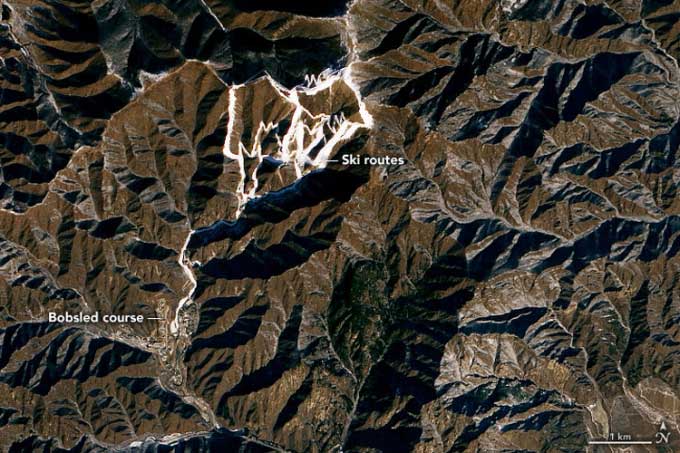Landsat 8 Satellite Captures Artificial Snow-Covered Areas Standing Out Against a Dry Landscape.
The Landsat 8 Satellite captured an image of the Yanqing Olympic Zone on Xiaohaituo Mountain, northwest of Beijing, on January 29. The photo illustrates the stark contrast between the artificial snow-covered areas designated for the Winter Olympics and the surrounding barren rocky mountains.

Image captured by Landsat 8 on January 29 shows artificial snow used for sports at the Yanqing Olympic Zone, northwest of Beijing. (Photo: Joshua Stevens/Landsat/NASA Earth Observatory).
The area is being utilized for various sliding sports (luge, skeleton, bobsleigh) and downhill skiing, all of which require long snow or ice tracks, necessitating a substantial amount of snow. However, in February, this region typically receives an average of only 3.3 cm of snow, according to NASA’s Earth Observatory.
As a result, the 2022 Winter Olympics became the first Winter Olympics to rely almost entirely on artificial snow for all snow sports, including ski jumping, freestyle skiing, and cross-country skiing, according to a recent report by researchers at Loughborough University in the UK. The use of artificial snow has sparked significant debate and backlash from environmentalists and some athletes.
Producing artificial snow requires massive amounts of water and energy. In the recent report, scientists estimated that the 2022 Winter Olympics used at least 1.2 million cubic meters of artificial snow, which translates to approximately 223 million liters of water. To generate this volume of snow, organizers installed 300 snow guns powered by 130 generators, supported by 8 cooling towers and 3 pumping stations. Meanwhile, China claimed that the Winter Olympics operated on 100% renewable energy.
Artificial snow also poses other environmental issues. To maximize the longevity of the synthetic snow, manufacturers add chemicals to the water to prevent melting. These chemicals can significantly harm vegetation covered by snow, and the runoff can affect nearby areas. Additionally, the slow melting of artificial snow may disrupt the normal behaviors of flora and fauna. Furthermore, noise pollution from snow guns can adversely impact local wildlife.
The composition of artificial snow creates some differences for athletes. Artificial snow consists of approximately 30% ice and 70% air, while natural snow is nearly 10% ice and 90% air. Researchers noted that this difference makes artificial snow slopes denser and harder compared to natural snow slopes that athletes typically train on. Consequently, even experienced athletes may be at risk of falling. The artificial conditions may also exacerbate injuries resulting from accidents.
During the first few days of the 2022 Winter Olympics, several incidents occurred in downhill skiing. Accidents and injuries are always significant risks for downhill skiers, and currently, no injured athletes have directly blamed the artificial surface. However, some fans and spectators suggest that it may be a contributing factor. Only after all competitions conclude will the organizers be able to accurately assess the impact of artificial snow on athletes.
Researchers also indicated that despite the controversies surrounding artificial snow, climate change may lead to its increased prevalence at future Winter Olympics. “From the Alps to the Pyrenees, the Rockies to the Andes, snow sports fans are witnessing shorter seasons, less snowfall, and melting glaciers,” they stated.
- “The Dark Side” of Artificial Snow at the Beijing Winter Olympics
- Secrets of Quantum Technology Creation, China Leaves the U.S. “Sitting on a Powder Keg” with 3 Trump Cards
- A Young Man Shares a Rare Plant with Blue Flowers, Netizens Claim It’s Extremely Precious in Vietnam
- Interesting Facts About Ice Skating Competition Outfits





















































